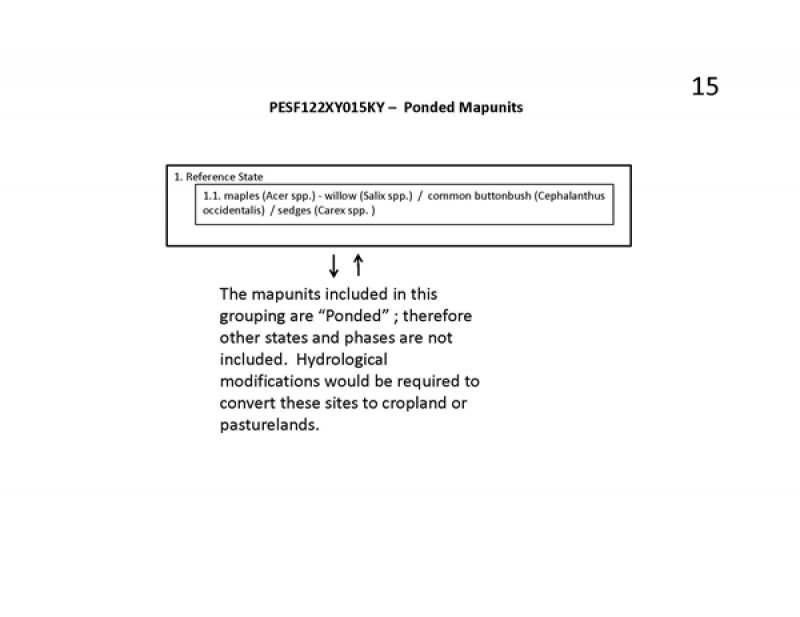
Natural Resources
Conservation Service
Ecological site F122XY015KY
Ponded Sites
Last updated: 5/14/2025
Accessed: 12/21/2025
General information
Provisional. A provisional ecological site description has undergone quality control and quality assurance review. It contains a working state and transition model and enough information to identify the ecological site.
MLRA notes
Major Land Resource Area (MLRA): 122X–Highland Rim and Pennyroyal
MLRA 122 is in Tennessee (47 percent), Kentucky (43 percent), Indiana (7 percent), and Alabama (3 percent). It makes up about 21,530 square miles (55,790 square kilometers).
SOILS:
Many of the soils in this MLRA are Udalfs. The moderately deep to very deep, well drained, clayey soils formed in limestone residuum. They are dominantly in rolling to steep areas of the “Outer Basin” (Mimosa, Braxton, Gladdice, and Hampshire series) and the undulating to hilly areas of the “Inner Basin” (Talbott and Bradyville series). The most agriculturally productive soils are the very deep, well drained, clayey or loamy soils that formed in alluvium and/or loess over alluvium or limestone residuum in nearly level to undulating areas (Armour, Cumberland, Harpeth, Lomond, and Maury series). The less extensive soils generally are moderately well drained to somewhat poorly drained and formed in loamy or clayey alluvium and/or residuum (Byler, Capshaw, Colbert, and Tupelo series). This MLRA has a significant acreage of Mollisols. Shallow or moderately deep, well drained, clayey Udolls (Ashwood and Barfield series) formed in limestone residuum dominantly in rolling to steep areas. Very shallow, well drained, clayey Rendolls (Gladeville series) formed in limestone residuum dominantly in undulating to rolling areas of the “Inner Basin.” Very deep, well drained or moderately well drained Udolls (Arrington, Egam, Lynnville, and Staser series) and somewhat poorly drained or poorly drained Aquolls (Agee, Godwin, and Lanton series) formed in loamy or clayey alluvium derived from limestone on flood plains. Most of the remaining soils on flood plains are moderately well drained or well drained Udepts (Lindell and Ocana series). Udults are of small extent in this area. Most are very deep, well drained, and loamy and formed in gravelly colluvium or colluvium and the underlying residuum on steep hillsides (Dellrose soils). Rock outcrops are common on uplands.
BIOLOGICAL RESOURCES:
This area supports mixed oak forest vegetation. White oak, black oak, northern red oak, and some scarlet oak are the dominant tree species. Shagbark hickory, bitternut hickory, pignut hickory, and mockernut hickory also occur. Oak, blackgum, flowering dogwood, sassafras, Virginia pine, pitch pine, and shortleaf pine grow mostly on ridgetops.
(Excerpt from United States Department of Agriculture, Natural Resources Conservation Service. 2006. Land Resource Regions and Major Land Resource Areas of the United States, the Caribbean, and the Pacific Basin. U.S. Department of Agriculture Handbook 296.)
Classification relationships
Scientific Name: Central Interior Highlands and Appalachian Sinkhole and Depression Pond
Unique Identifier: CES202.018
Ponded mapunits compose this PES grouping. Vegetation on ponded mapunits will vary depending on their landscape position - upland depressions versus floodplains. Flooding regime and length of flooding will also influence vegetation. For this initial PES effort, all flooded mapunits have been placed into this group and future field work will result in more than one ESD.
Ecological site concept
The communities described in this provisional document reflect plant communities that are likely to be found on these soils and have not been field verified. This PES describes hypotheses based on available data of many different scales and sources and has not been developed utilizing site-specific ecological field monitoring. This PES does not encompass the entire complexity or diversity of these sites. Additional field studies would be required for detailed conservation planning or to develop a comprehensive and science-based restoration plan.
State 1, Phase 1.1: Forestland.
Plant species dominants will vary depending on the depth of ponding, period and frequency of ponding, drainage class of the soils, flooding regimes, and topographic setting (floodplains versus sinkholes).
Melvin soils are poorly drained and the ponded mapunits are usually characterized in floodplains and as swamps. Nolin soil mapunits are often upland sinkhole bottoms. Nolin and Grigsby are well-drained even though the mapunits included in this project are classified as “ponded” in NASIS.
Future field work and ESD development is required to specifically differentiate vegetative differences on individual mapunits.
This PES is a generalized description that is likely to be found on many sites.
State 1.0. Phase 1.1. Forestland:
Sinkhole depressions: maple (Acer spp.)- willow (Salix spp.) / common buttonbush (Cephalanthus occidentalis) / sedges (Carex spp.)
Floodplain mapunits in western MLRA 122 may closer resemble:
bald cypress (Taxodium distichum) – black willow (Salix nigra) / common buttonbush (Cephalanthus occidentalis) – swamp rose (Rosa palustris) / sedges (Carex spp.)
Future ESD development will refine this group.
Associated sites
| F122XY018KY |
Poorly Drained Alluvium Poorly Drained Alluvium |
|---|
Table 1. Dominant plant species
| Tree |
(1) Acer |
|---|---|
| Shrub |
(1) Cephalanthus occidentalis |
| Herbaceous |
(1) Carex |
Click on box and path labels to scroll to the respective text.
